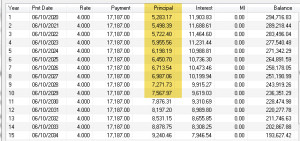How Home Ownership Builds Wealth
“Home Ownership is the key to building wealth”
Have you heard this before? A lot of people have heard this phrase, or some rendition of it, and it usually comes from a lender or real estate agent. What usually isn’t communicated as well is HOW home ownership builds wealth. HOW, through buying and holding real estate, does one go from rags to riches, or at least a more secure financial future?
It generally boils down to the 2 A-words – appreciation and amortization.
Appreciation
Over time, homes have a tendency to increase in value. This increase is influenced by various economic factors, but historically, home prices have fared well and have gone up more years than not. If you look at the Case Shiller Home Price index, a measure of home values, historically you’ll see how well home values have done. Anyone buying and holding real estate increases their wealth simply by holding an asset that’s appreciating in value. And since home prices are so high, the percentage values increase can become a very large dollar amount. For example, in a year when a $1 million home appreciates 5%, the home owner technically has a $50,000 increase in their wealth.
While values aren’t guaranteed to increase, historical data and basic economics in most markets (supply VS demand) suggest real estate will be an appreciating asset in the future as it has been in the past. This will vary depending on economic conditions and locations (real estate is local!). But as you can see, if home prices continue to climb, whoever owns the homes will increase their wealth.
Amortization
A lesser discussed but also very important part of home ownership and financial planning lies in amortization. That is, the paying down (and eventually, paying off) of debt. If you look at this chart, a mortgage loan is broken up into 2 parts – principal and interest. It is amortized over a loan term (in this example, 30 years) at a rate of 4%. Each month, a portion of a borrowers payment goes toward the principal on their loan, or the amount of the loan that is paid off. This becomes equity for a home owner. In this example, if you add the principal amounts paid over 10 years, the mortgage holder will have built up more than $60,000 in additional home equity just by paying their mortgage. This is where the phrase and idea that “renters are paying someone else’s mortgage” comes from. If the home owner is renting their property and the renter is paying most or all of the mortgage payment, the home owner is benefiting from the amortization schedule on their mortgage AND enjoying the home appreciation while they own the property. The renter gets neither of these benefits, even if their rent payment is somewhat lower than a mortgage payment would be.

Amortization is an example of how mortgage debt can benefit home owners and provide a financial benefit that renting cannot
The powers of appreciation and amortization are 2 of the biggest factors in how home ownership builds wealth and working together, they can play a huge role in retirement planning, and the amount of net worth someone has after a period of 10, 20, or 30 years.
Want some help in growing your own wealth through home ownership? Have questions? Reach out to one of our loan experts to get started on your path to financial security!







